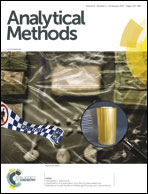The preparation of an electrochemiluminescence (ECL) active DNA nanoprobe for label-free and amplified ECL sensing of microRNA†
Abstract
In this work, we report a new scheme to prepare a DNA nanoprobe by adsorbing oligonucleotides on the surface of electrochemiluminescence (ECL) active chitosan/Ru(bpy)32+/silica nanoparticles (CRuS NPs). Then, the characteristics of the DNA nanoprobes were also investigated by transmission electron microscopy (TEM), gel electrophoresis (GE), and zeta potential and contact angle experiments. Our results showed that, compared to the preparation schemes of previously reported nanoprobes, this new scheme is simple and general. More importantly, the proposed DNA nanoprobes also presented the features of rapidity, specificity and sensitivity for binding to target miRNA. In the initial state of the DNA nanoprobes, the DNA nanoprobes were hardly adsorbed on a Nafion/MWNT modified electrode, and only a very low ECL signal was detected from the ECL active CRuS NPs. However, while target miRNA was present in DNA nanoprobe solution, target miRNA could hybridize with DNA probes on the DNA nanoprobe surface. As a result, this reaction forced the DNA probes away from the surface of the nanoprobes. Rigid structured double stranded DNA-miRNA products and naked CRuS NPs were formed in the solution. In this case, based on the strong affinity interaction of CRuS NPs with the Nafion film, these naked CRuS NPs could effectively be pre-concentrated on the Nafion/MWNT modified electrode and produce a stronger ECL signal. Based on this ECL signal difference, this new ECL DNA nanoprobe could detect miRNA at a 0.03 pM level and was also successfully used for miRNA detection in serum samples.


 Please wait while we load your content...
Please wait while we load your content...